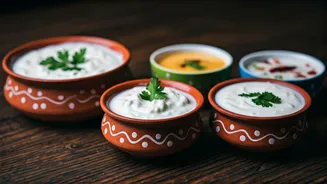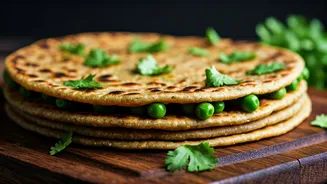Thepla: A Versatile Flatbread
Thepla, a staple in Gujarati households, is a thin, soft flatbread made from whole wheat flour, spices, and often, fenugreek leaves (methi). Its versatility
allows it to be enjoyed at any time of the day, paired with curd, pickle, or even sabzi. Traditionally, thepla is made during long journeys because it stays fresh for several days. This flatbread showcases the Gujarati preference for including vegetables and herbs in everyday meals. The methi variety, in particular, adds a slightly bitter, yet delightful taste. The thepla is commonly served with yogurt (dahi) or a spicy pickle, enhancing its flavour profile. Making thepla is a relatively simple process. The ingredients are mixed to form a dough, then rolled out thinly and cooked on a hot griddle with a little oil until golden brown. Its adaptability, portability, and delicious taste make it a favourite among Gujaratis, offering a wholesome and satisfying culinary experience. It’s a fantastic example of how simple ingredients can produce an incredibly flavourful dish.
Undhiyu: A Winter Specialty
Undhiyu is a mixed vegetable dish cooked upside down in earthen pots (matlu), traditionally over a slow fire. This cooking method infuses the vegetables with unique earthy flavours, and creates a delectable dish enjoyed primarily during the winter months. The blend includes root vegetables like potatoes, sweet potatoes, and various beans, all combined with a mix of spices and often a touch of sugar. It's a dish that varies across regions and families, with each home adding their distinct touch to the recipe. The vegetables are slow-cooked with a specific blend of spices that can include ginger-garlic paste, green chilies, coriander, and turmeric. Undhiyu often includes muthiya, which are small, savoury dumplings made from gram flour (besan) and spices, adding another layer of texture and flavour. Served with warm, fluffy puris or rotis, Undhiyu embodies the Gujarati tradition of rich, flavourful, and festive cuisine, especially during the cold season. The preparation and consumption of Undhiyu are cultural rituals, often shared during celebrations such as Uttarayan (kite festival).
Dhokla: A Steamed Delight
Dhokla, a steamed savoury cake, stands as a popular snack and breakfast item throughout Gujarat. Made from a fermented batter of rice and chickpea flour, it has a light, fluffy texture and a slightly tangy flavour. The fermentation process is key, creating the signature airiness and enhancing the taste. After steaming, dhokla is often tempered with mustard seeds, green chilies, and curry leaves, adding a burst of flavour and aroma. Varieties of dhokla exist, including the Khatta Dhokla (sour dhokla), Khaman Dhokla (made with gram flour), and Rava Dhokla (made with semolina). Dhokla is usually served with green chutney, sweet tamarind chutney, and a sprinkle of fresh coriander, offering a delightful mix of tastes and textures. It’s also a low-calorie option, which makes it a favourite among health-conscious people. Dhokla has become an integral part of Gujarati snacks, showcasing how simple ingredients can create a flavourful and appealing dish. Its versatility is seen in the many variations available, each offering a unique taste experience.
Khandvi: Rolled Savories
Khandvi is a delicate, rolled snack made from a mixture of gram flour and yogurt. The batter is cooked and spread thinly, then rolled up into bite-sized pieces. The flavour is delicately balanced by the slight tang of the yogurt and the spices used, and it's often garnished with mustard seeds, sesame seeds, and fresh coriander. The process of making khandvi requires precision to achieve the right consistency of the batter and avoid any tearing or breaking of the rolls. The simplicity of its ingredients belies the complexity of its texture and taste. The rolls are typically served as a snack or starter, providing a light and flavourful option. Khandvi shows the Gujarati skill in creating visually appealing and delicious dishes using simple ingredients, with each bite delivering a blend of textures and tastes. This snack is a popular option during festivals and get-togethers, celebrating the art of Gujarati cooking.
Fafda-Jalebi: A Classic Combo
The combination of Fafda-Jalebi is a quintessential Gujarati breakfast or snack pairing, particularly popular on Sundays and during festivals. Fafda is a crispy, savoury snack made from gram flour, shaped into thin strips and deep-fried until golden. Jalebi, on the other hand, is a sweet, syrupy dessert made by frying batter in circular shapes and soaking them in sugar syrup. The contrast between the salty fafda and the sugary sweetness of jalebi is what makes this combination so irresistible. Fafda is often served with a side of green chutney and fried green chilies, which complement the flavour and texture of the snack. The crunchy texture of the fafda combined with the soft, syrup-soaked jalebi provides a delightful culinary experience. This combo is more than just food; it's a tradition, connecting generations and showcasing the Gujarati penchant for balancing flavours and textures in their cuisine.
Gujarati Thali: A Feast
A Gujarati thali is an expansive platter that showcases the diversity of Gujarati cuisine. It typically includes a variety of dishes, such as dal (lentils), roti or puri (flatbreads), rice, vegetables, farsan (snacks), sweets, and papad. The variety ensures that one enjoys a well-balanced and flavourful meal. Each thali component is carefully selected and made to harmonise the different tastes. The thali offers a balance of flavours—sweet, sour, spicy, and savoury, reflecting the Gujarati culinary philosophy. The dishes often vary based on regional preferences and seasonal availability. Many restaurants and homes offer their unique take on the thali, creating a sense of discovery and delight for the diner. Gujarati thalis are perfect for experiencing a wide range of flavours in one sitting, making them a quintessential dining experience, and highlighting the complexity and the richness of Gujarati food.
Handvo: Savory Cake
Handvo is a savory cake made from a combination of lentils, rice, and vegetables, creating a wholesome and flavorful dish. The batter is fermented, allowing the flavours to meld, and the result is a soft, moist cake filled with various vegetables. The recipe can vary, with ingredients like bottle gourd, carrots, and spinach commonly added. Handvo is generally cooked in a pan or a pressure cooker, and the method creates a light, yet fulfilling snack. The preparation process involves soaking the lentils and rice, grinding them into a batter, and mixing in the vegetables and spices. This dish showcases the Gujarati inclination for incorporating vegetables into many meal preparations. Handvo is enjoyed as a snack or a side dish, offering a nutritious and flavourful option for any meal. Its versatility lies in the ability to customise it with a range of different vegetables. Its preparation is considered to be a home-style Gujarati recipe, with each family creating a unique flavour.
Dal Dhokli: A One-Pot Meal
Dal Dhokli is a complete and satisfying meal that combines the goodness of dal (lentils) with dhokli (wheat flour dumplings). The dhokli is cooked in a flavorful dal base, absorbing the delicious flavours of the lentils and spices. This dish reflects the efficiency of Gujarati cooking. Making dal dhokli involves kneading a dough, making small pieces, and cooking them in a flavorful lentil broth. This one-pot meal is a time-saver and creates a balanced meal of carbohydrates, proteins, and vegetables. The dal is typically made using toor dal (split pigeon peas), while the dhokli absorbs the flavours of the spices and the dal. This comforting dish is suitable for all occasions, showcasing the ability to combine ingredients and offer both simplicity and taste. Dal Dhokli is commonly served with a dollop of ghee (clarified butter) for added richness, making it a favourite comfort food in Gujarati households.
Kadhi: A Yogurt Delight
Kadhi is a light, tangy, and flavourful dish made from yogurt, gram flour, and spices. It is a staple side dish in Gujarati cuisine, often served with rice or khichdi. The sourness from the yogurt is balanced with the spices, such as ginger, chilies, and turmeric, creating a harmonious balance of tastes. The consistency varies from thick to thin based on the region or family preference. The process involves whisking yogurt and gram flour together, then simmering it with spices until it thickens. Kadhi is sometimes enhanced with fried dumplings called pakoras. The addition of curry leaves and mustard seeds add an extra layer of fragrance and flavour. The dish is commonly prepared at home and served as a refreshing accompaniment to main courses, which demonstrates the Gujarati appreciation for dishes with balanced flavors. Kadhi shows how basic ingredients can create a delightful and comforting food experience.




